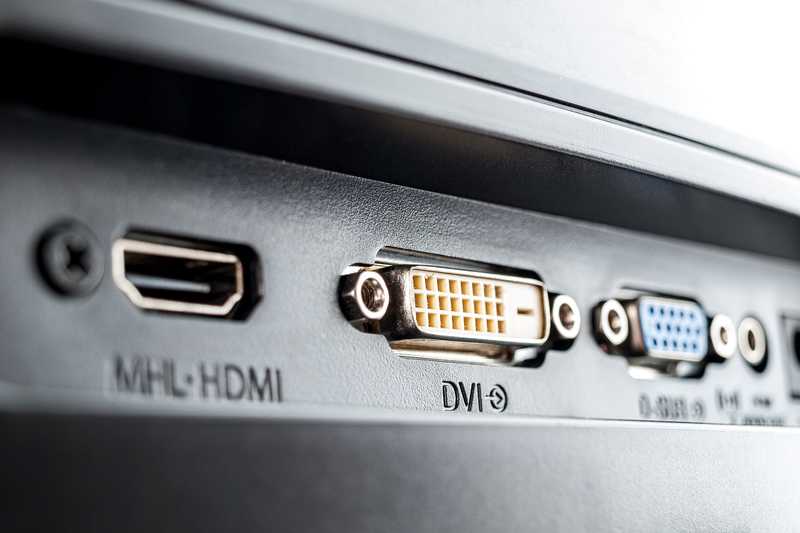
HDMI cables are largely present nowadays, in both homes and businesses, as the most common connection cable between the source and the display. What most people do not realise is that there is more than one type of HDMI port, and they focus on different features.
First of all, HDMI stands for High-Definition Multimedia Interface, and it was first conceived in the early 2000s as an improvement of the former HDTV audio and video cables.
Its convenience and functionality set it ahead of the DVI, which was better suited for PCs for its HD transmission quality, and the component, which delivered excellent quality of A/V (or Audio and Video), but through five separate cables.
The HDMI came to put all the former technologies into one convenient cable, and it was definitely successful. Within a couple of years, HDMI sales skyrocketed, making it pretty much the default option for audio and video signal transfer in both homes and businesses.
Finally, users could transfer extremely high-quality audio-visual signals through a sturdy cable.
For all that, HDMI cables became widely used for many purposes, such as watching movies from a Laptop on a TV set, connecting soundbars to obtain an enhanced audio quality, connecting streaming boxes and videogame consoles to TV sets, amongst others.
Regarding the variety of HDMI ports, this article aims at the comparison between only two types, the ARC and the MHL. Therefore, readers should not expect a full description of the other types, though there will be a few mentions.
As an example, TVs nowadays offer a variety of HDMI port types, such as ARC, MHL, SDB and DVI.
HDMI MHL vs ARC: What’s The Difference?
There have been several changes in the HDMI port types throughout the years, leading to a variety of options, and each one aims at a particular use. Once you get a good idea of what an HDMI port is and what its uses are, it comes the time when you must opt for the one that suits your needs better.
For that purpose, we brought you a comparison between the two types that offer the best overall quality, the MHL and the ARC. So, without further ado, here is what you need to know about those two types in order to make up your mind about which one you should choose.
| Feature | HDMI eARC | HDMI SuperMHL |
| Double-way audio transfer | Yes | No |
| 5.1 audio format | Yes | Yes |
| 7.1 audio format | Yes | Yes |
| Dolby Atmos and DTS:X | Yes | Yes |
| Maximum Bandwidth | 37 Mbit/s | 36 Gbit/s |
| Lip-Sync Correction | Mandatory | Mandatory |
| Maximum Resolution | 8K / 120 fps | 8K / 120 fps |
| Cable type | HDMI with Ethernet | SuperMHL proprietary, USB-C, Micro USB, HDMI Type A |
| Remote Control Protocol | Yes | Yes |
| Multi-Display Support | Not informed | Up to eight |
Why Choose HDMI ARC?
The ARC in HDMI ARC stands for Audio Return Channel and it is currently regarded as the standard kind of High-Definition Multimedia Interface port. The innovation that ARC HDMI ports brought was the two-direction transmission of audio signals.
To be more precise, HDMI ports used to only allow one way of audio signal transfer, which hindered both the quality and the latency, which is the time the audio signal takes from the moment it arrives at the speaker to the moment it is played.
ARC ports allow the audio signals to be transmitted both ways, but more specifically, to be sent forward, which created a more dynamic flow, increased the quality, and reduced the signal latency.
The best outcome of this new port type is that users did not need a second audio or optical cable for the audio features. The ARC technology came to reduce the number of cables in the setup of audio and video devices.
That is probably the main reason why TV manufacturers nowadays opt for ARC HDMI ports way more often than any other kind. One of the most common examples of ARC port use is the Blu Ray player, which demanded, in comparison to the latter DVD players, a higher quality of both audio and video.
Due to the fact that both audio and video signal transmissions were more intense with Blu Ray technology, HDMI ports that could offer the audio return feature suited that purpose better.
Even though the ARC port provides an output sound through the HDMI cable to the speakers, which is already an enhancement in the audio performance, it is mostly in the uncompressed format, which means stereo.
Meanwhile, the compressed type, which is only transmitted by the 5.1 audio format, has recently been added to the range of signal transmission of the ARC HDMI ports, via its 2.1 version.
That means, if your TV set is not one of the more recent ones, there is a big chance the compressed, or 5.1 format, won’t be available.
The more recent version offers the Steel support, which enables the 5.1 formats of audio, besides the one megabit per second audio bandwidth and the optional lip-sync correction. If you are not that acquainted with lip-sync features, it is a tool that corrects the audio delay.
A good example of lip-sync is when the character’s lips on a movie or series are moving but the audio only comes a little later. It’s annoying, we’re sur you’ll agree! By fixing this gap, the audio quality is enhanced as the experience becomes more real for the ones watching.
Why Choose HDMI MHL?
The MHL in HDMI MHL stands for Mobile High Definition and it uses a five-pin connector to deliver up-to 1080p image quality 192kHz audio quality and a 7.1 surround sound feature.
Due to the low count of pins, as well as the size, HDMI MHL ports are usually more commonly used to transmit audio and video files from smartphones, tablets and other mobile devices to high-definition TV sets or display components.
Additionally, HDMI MHL ports charge the devices while there are connected, which makes this kind of port even more attractive for mobile devices.
First released by Nokia, Samsung, Toshiba, Sony and Silicon Image in 2010, MHL has been frequently updated to reach a higher level of competition amongst HDMI ports.
The key difference here is that the MHL is a single-way port, which allows users to control their mobile devices to stream the audio and video into the TV set or display component.
Also, the first versions of the MHL port did not allow the remote control of the connected devices, which means users had to keep both the mobile device and the TV remote control to enjoy all the features at the same time.
Even though many users have noticed an uncanny resemblance to the HDMI-USB connection, the MHL port takes the lead when it comes to overall performance.
Throughout the years, MHL has gone through a few updates that brought new features and enhanced the ones it already had. For instance, the MHL 2.0 enhanced the charging capability to 7.5 watts at 1.5 amp and added the 3D compatibility.
The 3.0 version brought 4k definition, Dolby TrueHD and DTS-HD video features, improved the RCP, or Remote-Control Protocol, allowing the control by touchscreen devices, keyboards, and mouses. It also increased the charging power to 10 watts and allowed the simultaneous display support.
The latest version, the SuperMHL, released in 2015, supports 8k definition with 120Hz HDR video features, Dolby Atmos and DTS:X audio formats and extended the RCP, allowing multiple devices to be controlled at the same time. Also, the charging feature was increased to 40W.
Although ARC and MHL may be used for the same audio or video formats, there are some differences worth noting. In order to facilitate the comparison, we brough you a table with the features of both HDMI ports.
Bear in mind that the table refers to the lates version of each port, which means the eARC and SuperMHL versions.
Therefore, even though the two options have a lot in common, the use of the HDMI port varies largely. So, get acquainted with the best option for you and enjoy the best features these technologies have to offer.
On a final note, should you come across other relevant differences between the HMDI eARC and the SuperMHL ports, don’t forget to let us know. Leave a note in the comments section and help your fellow readers get the best HDMI technology for their homes and businesses.


Can I use soundbar with HDMI ARC cord to TV with HDMI MHL outlet or other normal HDMI outlet only.